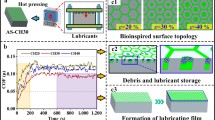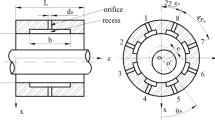Abstract
Taking the double-cone expansion joint sleeve (EJS) as an example, this paper proposes a hybrid prediction method of load-carrying capacity considering the displacement boundary conditions of EJS and rotation angle of spindle, and a comprehensive optimization method for the structure of EJS is established using this method. Firstly, based on the thick-walled cylinder theory and considering the displacement boundary conditions of interference contact surface, a new calculation method for calculating torque is presented, and the main parameters affecting load-carrying capacity are determined. Secondly, the finite element method is used to simulate assembly process and working process of EJS to obtain the ultimate torque, the effects of inner ring, outer ring, taper, elastic modulus, and friction coefficient are investigated. Based on the hybrid prediction results of load-carrying capacity, the multi-objective optimization is carried out using genetic algorithm through the construction of orthogonal experimental combination, the optimization of structural parameters of EJS is realized. The results indicate that the maximum equivalent stress is reduced by 20.88 %, the ultimate torque is increased by 0.23 %, and the mass is reduced by 5.11 %. It is proved that the method can effectively reduce maximum equivalent stress and solve design defects caused by stress concentration.
Similar content being viewed by others
Abbreviations
- E 1, E 2, E 3 :
-
Elastic modulus of spindle, inner ring and cone sleeve
- v 1, v 2, v 3 :
-
Poisson ratio of spindle, inner ring and cone sleeve
- Δ1 :
-
Deformation of outer surface of spindle
- Δ2 :
-
Deformation of inner surface of inner ring
- Δ3 :
-
Deformation of outer surface of inner ring
- Δ4 :
-
Deformation of inner surface of cone sleeve
- d 0 :
-
Spindle inner diameter
- d :
-
Outer diameter of spindle
- p 1 :
-
Pressure of the interface between spindle and inner ring
- p 2 :
-
Pressure of the outer surface of inner ring
- D xi :
-
Average diameter of i th unit
- L :
-
Length of tapered section
- α :
-
Oblique taper
- h 1 :
-
Thickness of thin-walled end of inner ring
- D :
-
Outer diameter of outer ring
- R 1 :
-
Assembly clearance
- δ 2 :
-
Surface interference
- L′:
-
Displacement of axial load-carrying area
- m:
-
Mass of EJS
- T :
-
Torque
- S :
-
Maximum equivalent stress
References
D. B. Marghitu, Mechanical Engineer’s Handbook, Elsevier, Amsterdam (2001).
F. Zeng et al., In situ observation and analysis of a shrink-fitted PMMA shaft subjected to rotating bending, Tribology International, 48 (2012) 149–154.
P. Pedersen, On shrink fit analysis and design, Computational Mechanics, 37(2) (2006) 121–130.
Y. Sun et al., Numerical simulations of the fatigue damage evolution at a fastener hole treated by cold expansion or with interference fit pin, International Journal of Mechanical Sciences, 107 (2016) 188–200.
J. Sohn and N. Park, Geometric interference in cylindrical worm gear drives using oversized hob to cut worm gears, Mechanism and Machine Theory, 100 (2016) 83–103.
T. Apatay, E. Arslan and W. Mack, Elastic-plastic design of a rotating shrink fit with functionally graded hub, Archive of Applied Mechanics, 87(11) (2017) 1829–1843.
U. Güven, The shrink fit with elatic-plastic hub exhibiting variable thickness, Acta Mechanica, 89(1–4) (1991) 65–72.
D. Croccolo and M. De Agostinis, Analytical solution of stress and strain distributions in press fitted orthotropic cylinders, International Journal of Mechanical Sciences, 71 (2013) 21–29.
X. Wang et al., Prediction of stress distribution in press-fit process of interference fit with a new theoretical model, Proceedings of the Institution of Mechanical Engineers, Part C: Journal of Mechanical Engineering Science, 233(8) (2019) 2834–2846.
X. Wang et al., A new analytical method for press-fit curve prediction of interference fitting parts, Journal of Materials Processing Technology, 250 (2017) 16–24.
J. Wang, J. Kang and L. Tang, Theoretical and experimental studies for wind turbine’s shrink disk, Proceedings of the Institution of Mechanical Engineers, Part C: Journal of Mechanical Engineering Science, 229(2) (2015) 325–334.
J. M. Wang et al., Reliability-based robust design of wind turbine’s shrink disk, Proc. IMechE, Part C: J. of Mechanical Engineering Science, 232 (2018) 2685–2696.
Z. Bai et al., Contact pressure algorithm of multi-layer interference fit considering centrifugal force and temperature gradient, Applied Sciences, 8 (2018) 1–12.
W. Mack, Thermal assembly of an elastic-plastic hub and a solid shaft, Archive of Applied Mechanics, 63(1) (1993) 42–50.
U. Gamer and R. H. Lance, Residual stress in shrink fits, International Journal of Mechanical Sciences, 25(7) (1983) 465–470.
G. M. Yang et al., Influence of roughness on characteristics of tight interference fit of a shaft and a hub, International Journal of Solids and Structures, 38(42) (2001) 7691–7701.
B. Alfredsson and A. Cadario, A study on fretting friction evolution and fretting fatigue crack initiation for a spherical contact, International Journal of Fatigue, 26(10) (2004) 1037–1052.
P. CatalĂ et al., Evaluation of the influence of a planned interference fit on the expected fatigue life of a conjugate cam mechanism-a case study, Journal of Mechanical Design, 135(8) (2013) 1–8.
N. L. Pedersen, On optimization of interference fit assembly, Structural and Multidisciplinary Optimization, 54(2) (2016) 349–359.
G. Liu et al., Investigation on the influence of interference fit on the static and dynamic characteristics of spindle system, The International Journal of Advanced Manufacturing Technology, 99(5–8) (2018) 1953–1966.
A. Boschetto, Interference fit of material extrusion parts, Additive Manufacturing, 25 (2019) 335–346.
K. Ning et al., Multi-objective intelligent cooperative design for the multilayer interference fit, Mathematical Problems in Engineering, 2019 (2019) 1–16.
Q. Shao, X. Liu and W. Zhao, An alternative method for analyzing dimensional interactions of urban carrying capacity: case study of guangdong-hong kong-macao greater bay area, Journal of Environmental Management, 273 (2020) 1–12.
Y. Li and D. Jiang, Dynamic carrying capacity analysis of double-row four-point contact ball slewing bearing, Mathematical Problems in Engineering, 2015 (2015) 1–7.
D. J. Armaghani, H. Harandizadeh and E. Momeni, Load carrying capacity assessment of thin-walled foundations: an ANFIS-PNN model optimized by genetic algorithm, Engineering with Computers (2021) 1–23.
Z. Wand and X. Guo, Bearing capacity evaluation of tunnel-type anchorage based on artificial intelligent algorithm, Journal of Southwest Jiaotong University (2020) 1–7.
R. Teng et al., Mechanical properties and design method of cylindrical interference fit, Journal of Mechanical Engineering, 13 (2012) 160–166.
P. Li, Research on fatigue life of thin-wall taper sleeve on macro-micro cross-scale behavior, MA Thesis, Taiyuan University of Science and Technology, China (2016).
Y. Guo et al., Theoretical and experimental study on gear-coupling contact and loads considering misalignment, torque, and friction influences, Mechanism and Machine Theory, 98 (2016) 242–262.
S. J. Chu, T. K. Jeong and E. H. Jung, Effect of radial interference on torque capacity of press-and shrink-fit gears, International Journal of Automotive Technology, 17(5) (2016) 763–768.
J. Wang et al., Modeling and finite element analysis of load-carrying performance of a wind turbine considering the influence of assembly factors, Applied Sciences, 7(3) (2017) 1–12.
J. Zhao et al., Influence of radial interference on torque capacity of shrink-fit camshaft, Advances in Mechanical Engineering, 11(4) (2019) 1–10.
J. Wang et al., Algorithm research on contact pressure and magnitude of interference for multi-layer cylinder’s interference fit, Engineering Mechanics, 9 (2013) 278–283.
D. H. Lee et al., Effects of hub contact shape on contact pressure and fatigue life in a press-fitted shaft, Materials Science Forum, Trans. Tech. Publications, 654 (2010) 1638–1641.
E. H. Hasan et al., Loading frame design for low capacity dead weight machines, Journal of the Brazilian Society of Mechanical Sciences and Engineering, 38(3) (2016) 955–964.
H. W. Volkmer and D. Xie, Study of local and nonlocal Poisson-Boltzmann equations for linear and nonlinear models with spherical symmetry, Journal of Computational and Applied Mathematics, 362 (2019) 653–662.
P. R. Caixeta and F. D. Marques, Multi-objective optimization of an aircraft wing design with respect to structural and aeroelastic characteristics using neural network metamodel, Journal of the Brazilian Society of Mechanical Sciences and Engineering, 40(1) (2018) 1–11.
Acknowledgments
This research has been supported by National Natural Science Foundation of China (No. 51875382, No. 52035006), Shanxi Provincial Key Science and Technology Special Projects (No. 20181102023) and Research Project Supported by Shanxi Scholarship Council of China (No. 2020-125).
Author information
Authors and Affiliations
Corresponding author
Additional information
Wang Jianmei is a Doctoral Tutor at the Taiyuan University of Science and Technology, and is currently the Executive Deputy Director of the Engineering Research Center of the Ministry of Education of Heavy Machinery. She received a postdoctoral degree from Taiyuan Heavy Industry Co., Ltd. She has visited and studied at Wollongong University in Australia and University College London in the UK. Her research interests include tribology and interface science, research and development of key basic components of major equipment, electromechanical system control and automation.
Rights and permissions
About this article
Cite this article
Guan, Y., Wang, J., Ning, K. et al. Hybrid prediction method of load-carrying capacity considering boundary condition of expansion joint sleeve and rotation angle of spindle. J Mech Sci Technol 35, 4605–4615 (2021). https://doi.org/10.1007/s12206-021-0929-x
Received:
Revised:
Accepted:
Published:
Issue Date:
DOI: https://doi.org/10.1007/s12206-021-0929-x




